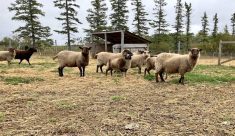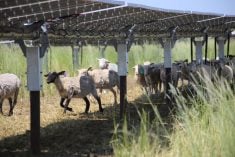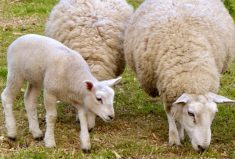The North American Lamb Company (NALCO) started with lofty goals — and some sharp criticism of the sheep sector — when it was launched in 2018.
“I will tell you right now that the sheep business, in my opinion, is a dysfunctional and declining business and I’m not saying that solely about the Canadian business,” Gary Alexander, president of the newly formed company, said at the annual meeting of the Alberta Lamb Producers four years ago.
[READ MORE] Lamb sector roiled by fall of major player
Read Also

VIDEO: Claas Axion 9 tractors showcase comfort features
German equipment manufacturer Claas showcased its new Axion 9 tractor series, including farmer-focused cab features, at the Agritechnica 2025 machinery show in November.
The problem, he said, was lack of consistency — not just in having year-round supply but also in terms of genetics, the weight and age of lambs when slaughtered, and how they were fed and raised.
“If you’re not market-led, forget it,” Alexander said then. “Right now, we don’t provide the market much. We’re lucky we even have markets.”
NALCO found buyers for its products and sold tens of millions of dollars’ worth of lamb. But there was no luck, or profits, on the financial side. Eventually it would unravel, with partners feuding and lenders “expressing their concerns that NALCO lacked executive leadership and was rudderless,” according to a court document.
The company was formed in summer 2018 when Canada Sheep and Lamb Farms, which had large-scale breeding barns in Manitoba, merged with Canada Gold.
The former was owned by Integrated Foods Group, a major New Zealand lamb producer and processor. The latter was owned by 207 AB Ltd., whose shareholders “consist primarily of ranchers and feedlot operators in southern Alberta,” according to the court documents.
It put its large feedlot at Iron Springs and processing plant at Innisfail (which people still refer to as the SunGold plant) into the company for a 41 per cent stake in the new entity.
The plan was that a crop of lambs would be born each week in the Manitoba barns with the 25,000 breeding ewes producing 70,000 lambs annually. At eight weeks, they would be weaned, put into a feeding facility in Manitoba for another six, and then sent to Iron Springs for finishing and eventually for processing at Innisfail, the country’s largest lamb processor and the only federally licensed one west of Ontario.
The new company did sell a lot of lamb — $29.8 million worth in 2020 and $34 million last year — and its clients included major grocery chains such as Sobeys and Save-On-Foods. But expenses were far higher, and the company lost $9.3 million in 2020 and another $8.5 million last year, according to financial statements filed with the court.
In fact, the company never made money, Alexander said in an affidavit filed as part of the creditor protection application.
The business “was financially supported by approved share capital raises and unsecured shareholder loans” almost entirely from Fresh Canada Meats, the Integrated Foods division that held its 59 per cent share.
By last fall, relations between the two partners had become “somewhat strained” and the five-member board “deadlocked and dysfunctional,” Alexander said in his affidavit.
By May, the company had “run out of operating funds” and stopped paying “non-essential creditors” so it could pay its 160 employees and buy feed for its livestock numbering just over 56,000 head as of mid-July.
It’s major lenders, the Bank of Nova Scotia and Farm Credit Canada, were notified and a series of events quickly unfolded with Alexander resigning in mid-June, the other four board members resigning soon after, the lenders calling their loans, and eventually a court order giving the company protection from creditors and having Ernst & Young monitor its operations.
The company owes just over $52.9 million, with more than 90 per cent of that owed to the trio of FCC ($24.2 million), the Bank of Nova Scotia ($14.5 million) and Fresh Canada Meats ($10.1 million).
But the list of creditors runs to nearly five pages, with the names of about 250 companies or individuals on it. While there are many national companies and many of the debts are small, there are also truckers, welders, hay suppliers and other small businesses owed four- and five-figure amounts.















